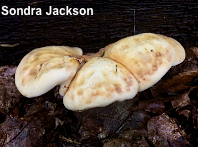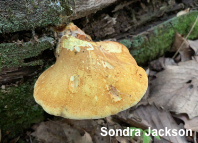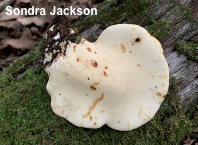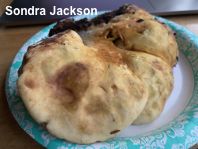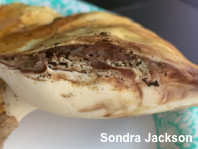| Major Groups > Polypores > Buglossoporus quercinus |

|
Buglossoporus quercinus [ Basidiomycota > Polyporales > Fomitopsidaceae > Buglossoporus . . . ] by Michael Kuo This distinctive polypore is found on the wood of oaks in Europe and in eastern North America from New York to Virginia. It features a yellowish cap that lacks a clearly differentiated cuticle, and a creamy pore surface with very tiny pores. Its surfaces and flesh bruise pink to purplish. Buglossoporus quercinus is treated as a rare find in European literature, and it is virtually absent from North American literature and herbaria. However, online reports of it in the Mid-Atlantic states are not uncommon (several dozen reports within a few years); perhaps the species has been recently introduced through human activities and is flourishing in its new digs. Buglossoporus pulvinus and Piptoporus quercinus are synonyms. Thanks to Sondra Jackson for collecting, documenting, and preserving Buglossoporus quercinus for study; her collection is deposited in The Herbarium of Michael Kuo. Description: Ecology: Saprobic and parasitic on living and dead oaks; causing a brown rot; annual; growing alone or gregariously; summer; originally described from Germany; widely distributed in Europe; in North America appearing from New York to Virginia. The illustrated collection is from Maryland. Cap: 10–20 cm across; sometimes partially fused with neighboring caps; semicircular to tongue-shaped in outline; broadly convex; without a differentiated cuticle ("skin"); soft and sub-velvety to the touch; dull yellow to brownish yellow, maturing to yellow-brown; paler at the margin; bruising pink to purplish. Pore Surface: Cream colored; bruising pink to purplish, then slowly brown; pores very small (3–5 per mm); tubes to 5 mm long. Stem: Absent. Flesh: Whitish; staining pink to purplish when bruised or sliced; corky. Odor: Usually subfragrant—like toast or chickory. Microscopic Features: Spores: 6–8 x 2.5–3.5 µm; allantoid; smooth; hyaline in KOH; inamyloid. Cystidia not found. Setae not found. Hyphal system dimitic: context composed of skeletal hyphae; tube trama composed of thin-walled hyphae 2.5–3 µm wide, smooth, hyaline to orange-brown in KOH, with clamp connections. REFERENCES: (H. A. Schrader, 1794) F. Kotlába & Z. Pouzar, 1966. (Calonge et al., 2003; Kotiranta et al., 2005; Crockatt, 2008; Han et al., 2016; Kibby, 2017; Læssøe & Petersen, 2019; Shen et al., 2019; Szczepkowski et al., 2019.) Herb. Kuo 06232201. This site contains no information about the edibility or toxicity of mushrooms. |
© MushroomExpert.Com |
|
Cite this page as: Kuo, M. (2022, August). Buglossoporus quercinus. Retrieved from the MushroomExpert.Com Web site: http://www.mushroomexpert.com/buglossoporus_quercinus.html |
